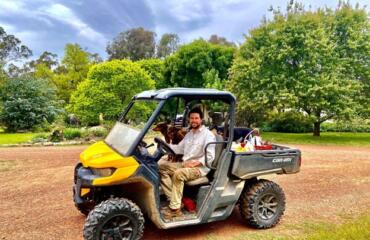
The hunt for Robbie B crossed state borders and hundreds of kilometres.
Robbie was under watch. Nine days earlier and against his will, he was fitted with a tracking device: a computer chip like those inside the ankle bracelets worn by sex offenders.
Yet Robbie was no criminal. He was less than four-months-old.
Had he been human, many would be deeply disturbed by this forced fitting of an electronic chip, especially on one so young.
But Robbie is a bird, an Australasian bittern, one of Australia’s most endangered species.
Australasian bitterns look like scruffy brown herons. Shy and not well known, there are fewer than 3000 in the world, with most living in Australia. Biologists are using satellites to learn about their habits and to track their movements. Robbie B is the first Australasian bittern to wear a GPS.
It is hard to catch a bittern without getting bitten: Robbie’s capturers, biologists Matt Herring and Inka Veltheim, were forced to wear safety glasses for protection.
“He was really feisty,” conceded Mr Herring.
The scientists covered Robbie’s head to settle him, rested a GPS on his back and tied two nylon straps above and below his wings, like a miniature backpack. Then they placed him on the ground.
“It was quite surprising,” Mr Herring continued. “I expected he would fly away but he just walked.” A few minutes later, Robbie disappeared in the rushes.
Nobody saw Robbie for the next three weeks. But thousands tracked his progress on the web. With the fervour of a Justin Bieber fan, Mr Herring posted updates on the Bitterns in Rice website: “Robbie has moved interstate,” “Robbie is doing well,” “Robbie is back in Victoria,” “Robbie likes what he’s found,” and then, finally: “Robbie has been sighted.”

Thanks to his GPS chip, Robbie Bittern was spotted 550 km away, near a remote beach in south-west Victoria, far from his birthplace in western New South Wales.
Australasian bitterns usually live in shallow wetlands where they hide in thick reeds and eat fish, yabbies, frogs and insects. But most shallow wetlands in south-eastern Australia were drained long ago for crops and pastures. Fortunately, the bitterns found a new place to live: rice farms.
A few years ago – in a project supported by irrigation farmers and bird conservationists – Mr Herring discovered that 500 to 1000 bitterns would often congregate and breed in rice farms in southern New South Wales.
The irrigated crops resemble shallow wetlands and are “full of frogs, carp, yabbies and mice”, according to Mr Herring. “It has become clear that the population in the rice is the world’s largest breeding population” of the endangered bitterns.
But each March the habitat disappears when the water dries up and the farmers harvest their rice. And nobody knows where the bitterns go.
For decades, people have worked hard to restore drained natural wetlands. But the first step is obvious: just add water. “Water,” said Mark Bachmann of the Nature Glenelg Trust, “is the ingredient that underpins it all.”
The trust and other groups have returned water to thousands of hectares of parched swamps.
“It never ceases to amaze us when species respond when we put water back in the landscape,” said Mr Bachmann. “Whether it’s birds flying in or fish and frogs using the wetland again.”
“Robbie reminded me of how connected the landscape and its people are. He’s not privy to water politics or state boundaries and other inventions. He just sees one big landscape.” — biologist Matt Herring
Like many others, Bachmann and his team watched Robbie fly south from the rice fields. “We joked at the time: wouldn’t it be nice if he came and visited our new restoration site.”
Robbie delivered. First, he visited a wetland in South Australia called Pick Swamp. Ten years earlier, the swamp was a dry, drained paddock. But in 2007 the drains were filled and a levee and spillway were built to restore the wetland’s hydrology.
Robbie approved. He stayed a few days and then flew to the Victorian coast where he bedded down at Long Swamp, which Nature Glenelg Trust and volunteers had restored just one month earlier. One Wednesday afternoon, 22 days after Robbie’s harness had been fitted, staff of the trust flushed a bird with a backpack from the rushes.
“To think that this one bird – that could have flown anywhere in Australia – decided to fly down to a swamp that literally we’ve just finished restoring. I mean, that’s an amazing coincidence,” said Mr Bachmann.
Robbie Bittern still lives at Long Swamp. “He seems to like what he’s found,” said Matt Herring on the prospect of Robbie spending his first winter in the restored wetland far from the rice farm where he was born.
“Robbie reminded me of how connected the landscape and its people are. He’s not privy to water politics or state boundaries and other inventions. He just sees one big landscape.”



